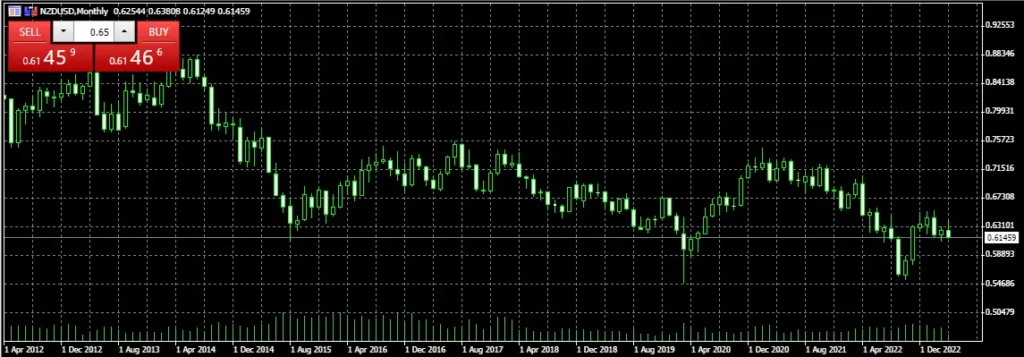The New Zealand dollar, also known as the Kiwi, is a major currency in the global financial market. It is the official currency of New Zealand, and it is also used in the Cook Islands, Niue, Tokelau, and the Pitcairn Islands. The NZD/USD currency pair is a popular choice among forex traders, as it offers a high degree of liquidity and volatility.
In this article, we will explore the performance of the Kiwi against the USD, including its historical trends, current state, and future outlook. We will examine various factors that influence the exchange rate between these two currencies, such as economic indicators, political developments, and market sentiment.
NZD/USD Historical Trends
The NZD/USD currency pair has a long history dating back to the early 20th century. During the 1920s, the New Zealand pound was pegged to the British pound, and the NZD/USD exchange rate was fixed at 1.00. In 1933, New Zealand abandoned the gold standard and devalued its currency, leading to a significant depreciation of the NZD/USD exchange rate.
In the 1970s, the New Zealand dollar replaced the pound as the official currency, and the NZD/USD exchange rate became a floating exchange rate. Since then, the exchange rate has experienced various fluctuations due to changes in the global economy and New Zealand’s domestic conditions.

Current State of NZD/USD
As of April 2023, the NZD/USD exchange rate is hovering around 0.68, which is relatively weak compared to its historical average. The Kiwi has been under pressure due to several factors, including:
- Economic Indicators: New Zealand’s economy has been facing several challenges, such as a slowdown in economic growth, high inflation, and a housing market bubble. These factors have weakened the Kiwi’s performance against the USD.
- Political Developments: New Zealand has been experiencing political instability, with frequent changes in government and policies. This uncertainty has created a negative sentiment towards the Kiwi, leading to a decline in its value.
- Market Sentiment: Global events such as the US-China trade war, Brexit, and the COVID-19 pandemic have also affected the performance of the NZD/USD currency pair. Investors tend to flock to safe-haven currencies like the USD during times of uncertainty, leading to a depreciation of the Kiwi.
Future Outlook of Kiwi against Dollar
The future outlook for the NZD/USD exchange rate is uncertain, as it depends on several factors that are subject to change. However, some analysts predict that the Kiwi could strengthen against the USD in the coming years due to the following reasons:
- Economic Recovery: New Zealand’s economy is expected to recover from its current challenges, which could boost the Kiwi’s performance against the USD. The government has introduced various measures to stimulate economic growth, such as increased infrastructure spending and tax incentives.
- Interest Rates: The Reserve Bank of New Zealand (RBNZ) has hinted at a possible increase in interest rates in the future, which could make the Kiwi more attractive to investors. Higher interest rates mean higher returns for investors, which could lead to a strengthening of the Kiwi.
- Global Events: The global economy is also expected to recover from the impact of the COVID-19 pandemic, which could improve the sentiment towards riskier currencies like the Kiwi. Additionally, a resolution to the US-China trade war could also lead to a depreciation of the USD, making the Kiwi more valuable.
However, there are also potential risks that could impact the future performance of the NZD/USD currency pair, such as:
- Inflation: New Zealand’s high inflation rate could persist and lead to a prolonged weakening of the Kiwi against the USD.
- Political Uncertainty: New Zealand’s political instability could continue, leading to a negative sentiment towards the Kiwi.
- Global Events: Unexpected global events such as natural disasters, geopolitical tensions, or pandemics could also impact the performance of the NZD/USD currency pair.
Conclusion
The performance of the Kiwi against the USD is influenced by a complex interplay of factors, including economic indicators, political developments, and market sentiment. The historical trends show that the NZD/USD exchange rate has experienced various fluctuations over time, but the current state is relatively weak compared to its historical average.
The future outlook for the NZD/USD currency pair is uncertain, as it depends on several factors that are subject to change. While there are potential risks that could weaken the Kiwi’s performance, there are also factors that could lead to a strengthening of the currency in the coming years.
As with any investment, forex traders should conduct thorough research and analysis before making any trading decisions. Understanding the factors that influence the NZD/USD exchange rate is crucial in making informed investment choices.
In summary, the Kiwi’s performance against the USD is a topic of great interest to forex traders and investors. By examining the historical trends, current state, and future outlook, we can gain a better understanding of the factors that impact the exchange rate between these two currencies.
Your Wolf Academy offers a range of educational resources to help traders succeed, including free signals, technical analysis, and weekly webinars. Sign up today and get a recommendation for a regulated brokerage company that suits your needs.


